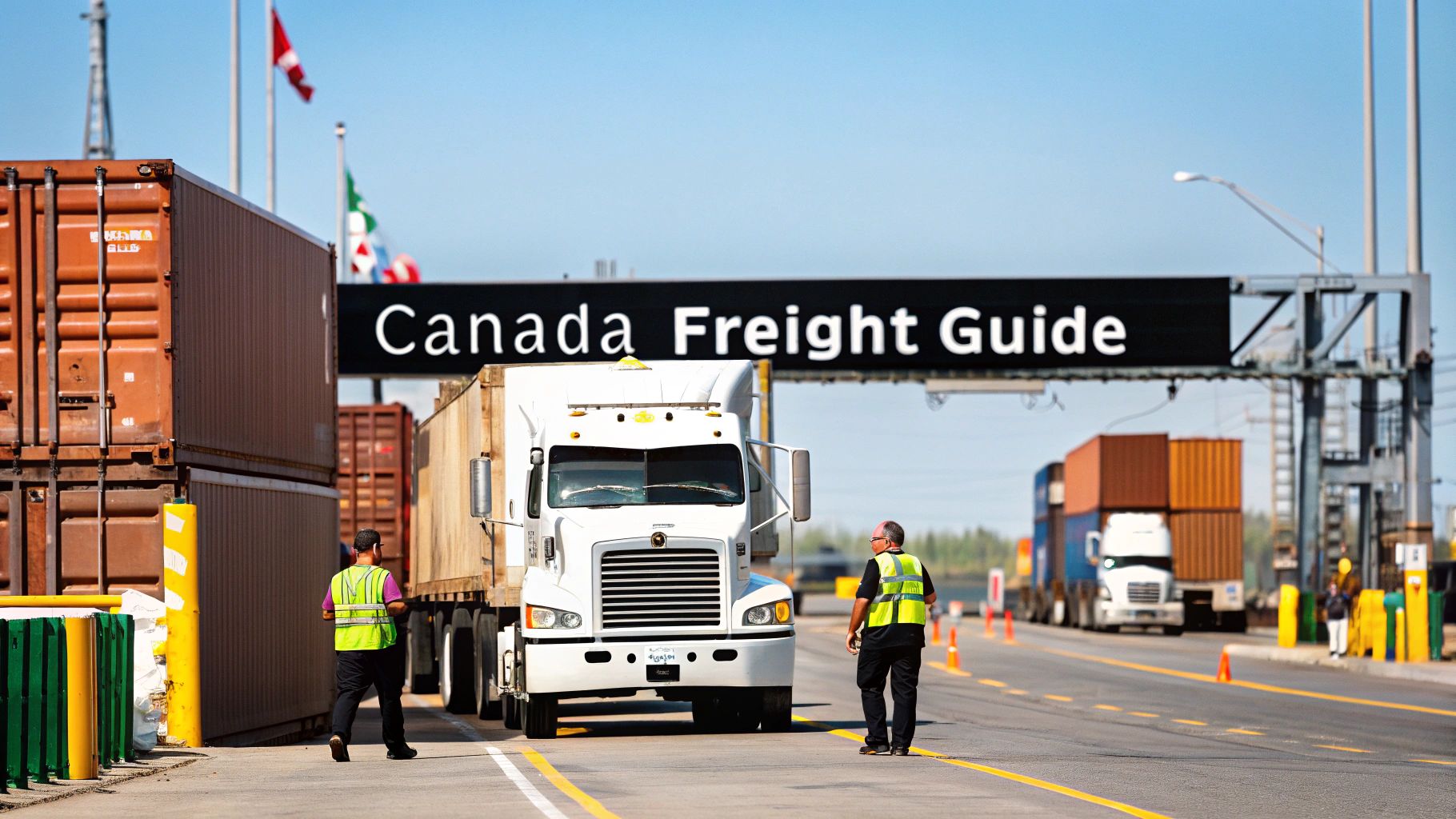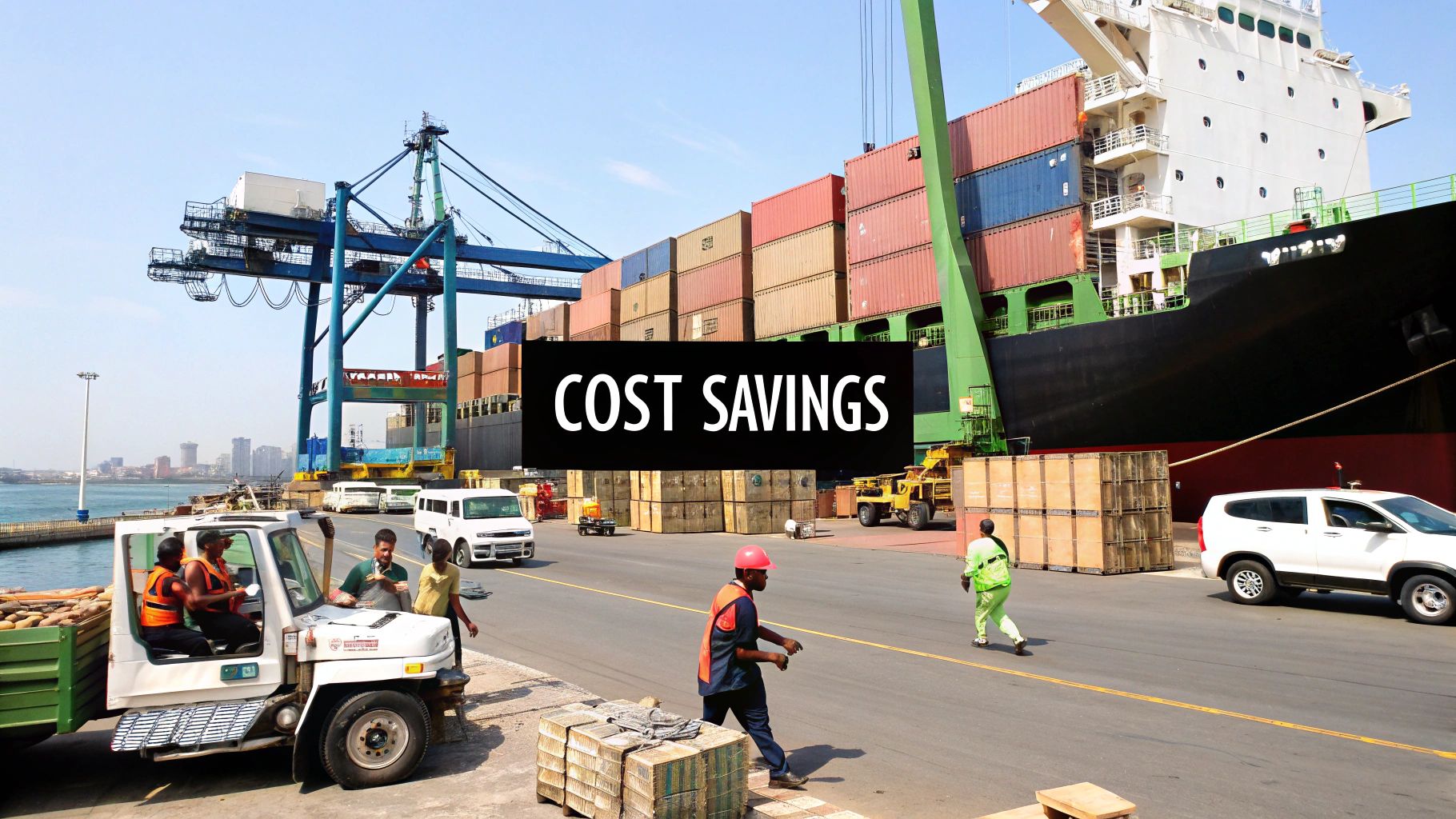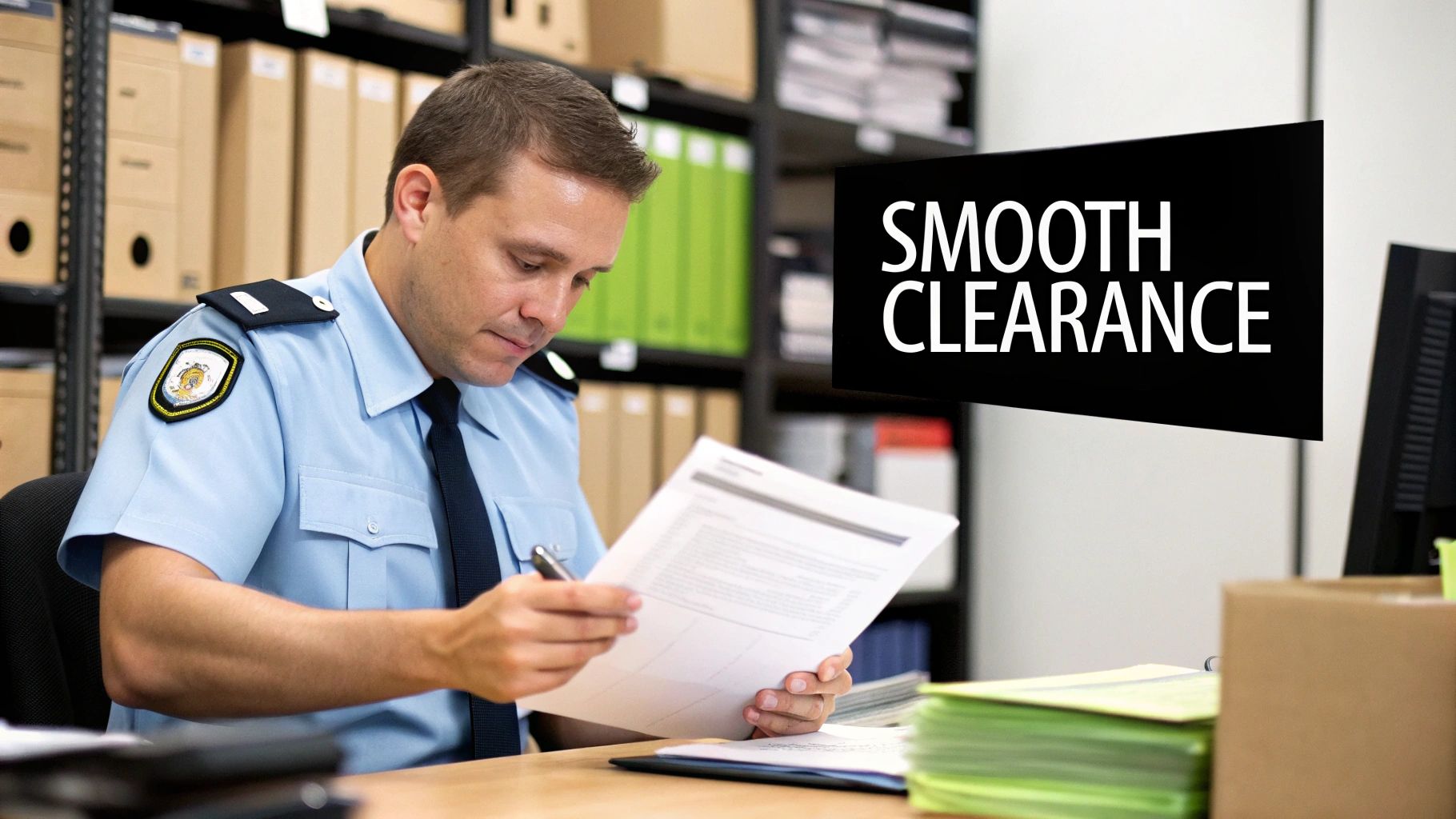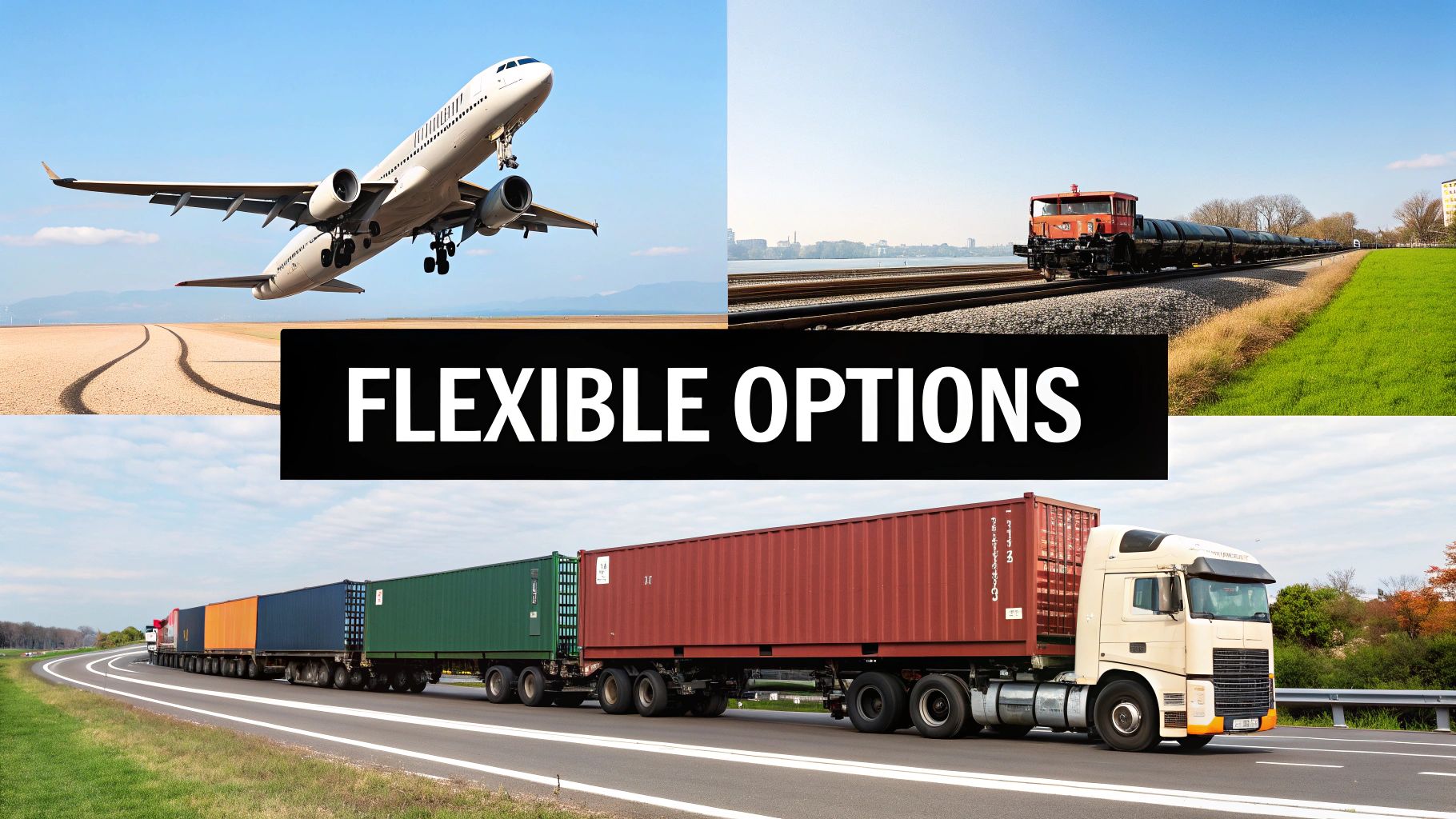Ship to Canada with confidence. Learn how to choose a freight forwarder to Canada, navigate customs, and optimize costs for LTL or FTL shipments.

Shipping to Canada can feel like a maze, but the right freight forwarder to Canada can be your secret weapon. Think of them less as just another vendor and more as a true partner who knows the ins and outs of getting your goods across the border. They become your go-to for making sure everything arrives without a hitch. Ready to find your partner? Get a free, instant quote for your next FTL or LTL freight shipment.
Let's be honest, when you're busy running your business, the last thing you want to become is an expert in international shipping regulations. That's where a skilled freight forwarder steps in. They take on the role of your advocate and coordinator, turning what feels like a complicated puzzle into a smooth, straightforward process. They handle the nitty-gritty so you can stay focused on the bigger picture.
This partnership is more critical now than ever. The freight forwarding market is a massive engine for North American trade, projected to hit US$184.94 billion in 2025 and swell to US$260.41 billion by 2032. As e-commerce and global trade continue to boom, Canada remains a central hub in this growth. If you're curious, you can discover more insights about this growing market and what it means for logistics.
A top-notch freight forwarder is so much more than someone who just books space on a truck. Their real value comes from their deep expertise and the extensive network they’ve built over years in the business. For anyone shipping goods between the U.S. and Canada, this relationship is a game-changer.
Here’s what they really bring to the table:
A freight forwarder is basically a travel agent for your cargo. They don't own the planes or trucks, but they have all the connections to book the best itinerary, handle the visas and paperwork, and make sure your goods have a smooth journey.
Ready to see the difference a real partner can make? Get an instant freight quote for your next LTL or FTL shipment to Canada and feel the weight lift off your shoulders. When your shipments are this important, you can't afford to leave things to chance.

Picking the right freight forwarder for your shipments to Canada is probably the most important decision you'll make in this whole process. It's about so much more than just snagging the lowest price. You're handing over a critical piece of your business to a partner, and you need to trust them to handle the maze of international shipping and protect your company's interests.
It’s easy to get drawn in by a lowball quote. I've seen it happen time and time again. But those tempting rates often hide nasty surprises like hidden fees, terrible communication, or a weak carrier network that ends up causing expensive delays. A real partner, on the other hand, adds value that goes way beyond a number on an invoice. They become an extension of your own team, proactively managing the details so you can stay focused on running your business. Don't leave it to chance—get a free instant freight quote for your FTL or LTL shipment to see what a true partner can offer.
Your very first filter should be finding a forwarder with specific, proven experience in the U.S.-Canada trade lane. This isn’t just another international route. It has its own unique rulebook, customs quirks, and common bottlenecks that can trip up the unprepared.
A forwarder who truly knows this corridor will be able to talk you through things like the PARS (Pre-arrival Review System) without blinking. They’ll have a solid game plan for dealing with the Canada Border Services Agency (CBSA) and know what it takes to keep freight moving. Think of their specialized knowledge as your first line of defense against costly headaches at the border.
Your ideal freight forwarder to Canada won't just move a box from point A to point B. They'll anticipate customs requirements, help you get your documents in order, and have a backup plan ready to go when things inevitably get complicated.
Here’s a big one: you need to find out how a forwarder handles customs clearance. Many will say they offer it, but the key question is whether they have their own in-house customs brokerage or if they farm it out to someone else. While both models can technically work, having an integrated, in-house team is a massive advantage. It gives you one seamless point of contact for the entire move.
When your forwarder and your customs broker work for the same company, communication is instant. Documents don't get lost in a messy handoff, and if a problem pops up—like a random inspection—the team can jump on it immediately. While a freight forwarder and a broker have different jobs, finding a single company that's great at both is a game-changer. For a closer look, we have a guide that breaks down the differences between a freight forwarder and a freight broker.
At the end of the day, a forwarder is only as good as the carriers they work with. A deep, reliable network means you get more options, better pricing, and the flexibility you need for both your FTL and LTL shipments.
Don't be shy about asking some tough questions:
Finally, take a look at their tech. A modern forwarder should give you access to a simple online portal where you can track your shipments, pull up documents, and see real-time updates. This kind of transparency isn't just a "nice-to-have" anymore; it's absolutely essential for managing your supply chain and keeping your own customers happy.
Crossing the Canadian border is the moment of truth for your shipment. This is where all your careful planning either pays off or falls apart. I've seen it happen time and again: even tiny mistakes can lead to frustrating delays and surprise fees. A top-notch freight forwarder to Canada does more than just move your boxes; they’re your personal guide through the maze of customs paperwork, making sure your freight gets across without a hitch.
Here's the thing about Canadian customs—it's not something you can just wing. The entire system is built on precision. The Canada Border Services Agency (CBSA) demands a specific set of documents, and they need to be perfect. Any little discrepancy can flag your shipment for a secondary inspection, instantly adding days and dollars to your budget.
Ready to stop guessing? Get a free, instant freight quote for your FTL or LTL shipment and let our experienced partners manage the tricky paperwork for you.
Getting your paperwork in order is absolutely non-negotiable. While your freight forwarder will steer the ship, knowing the key documents helps you give them the right information from the get-go.
When you're shipping to Canada, a few documents are the bedrock of the entire process. Here's a quick look at the essentials, what they do, and who's responsible for getting them ready.
Mistakes on these forms are, without a doubt, the #1 cause of border delays. A simple typo in a Harmonized System (HS) code or a value that doesn't match the commercial invoice can bring everything to a grinding halt.
This simple chart shows you how to think about choosing a partner to handle all this complexity.

As you can see, a successful partnership is about much more than just the lowest price. It’s about finding a forwarder who has the expertise to manage every single step.
So, who is the expert actually handling this critical paperwork? A freight forwarder arranges the truck, but a licensed customs broker is the specialist who talks directly to the CBSA to get your goods cleared. They live and breathe tariff classifications, duty rates, and import rules.
This is where you see a huge difference in service. Some forwarders just hand off your shipment to a separate, third-party broker. The best ones, however, have their own customs brokerage right in-house.
This integration is a game-changer. When your freight forwarder and customs broker are on the same team, communication flows seamlessly. There’s no risk of details getting lost between different companies. If a problem pops up at the border, the whole team can jump on it immediately to get it fixed.
This unified approach makes the whole process smoother, reduces your risk, and gives you a single point of contact for your entire shipment. One phone call, not a wild goose chase between two or three different companies.
Even with a fantastic partner in your corner, being aware of common slip-ups helps you get your information right from the start. From my experience, most issues trace back to incomplete or fuzzy details provided by the shipper.
Keep an eye out for these classic mistakes:
In the end, conquering Canadian customs is all about teamwork. Your job is to provide accurate, detailed information about what you're shipping. Your forwarder's job is to turn that information into flawless documentation that sails right through the border.
Don’t let paperwork become your biggest headache. Get an instant FTL or LTL freight quote now and find a partner who makes Canadian customs clearance simple.

Once you've picked a freight partner and have your paperwork lined up, the next big decision you make will have a direct line to your wallet and your delivery schedule. The question is: should your goods go Less-than-Truckload (LTL) or Full Truckload (FTL)?
This isn't just about how big your shipment is. It’s a strategic choice, and a good freight forwarder to Canada will be your guide in making the smart call. Choosing the right mode is really the secret sauce to cost-effective shipping.
FTL gives you speed and security by booking an entire truck just for your goods. LTL, on the other hand, offers serious savings by letting you share truck space—and the bill—with other shippers. Understanding the trade-offs here is how you really start to optimize your logistics budget. Get a free instant freight quote to compare LTL and FTL rates for your next shipment.
For smaller, more frequent shipments that won’t fill up a whole 53-foot trailer, LTL is almost always the way to go. Think of it as a rideshare for your cargo. Your pallets are loaded onto a truck with freight from other companies that are all headed in the same general direction.
Because you’re sharing the ride, you only pay for the space your shipment takes up, not the entire truck. It's a fantastic model for e-commerce businesses sending out individual orders or a manufacturer shipping a few sample pallets to a new distributor in Canada.
But, this flexibility comes with a trade-off. LTL trucks make multiple stops for pickups and drop-offs, so transit times are naturally a bit longer and harder to predict than with FTL. There’s also a slightly higher risk of damage since your freight gets handled more as it moves through different terminals.
A skilled freight forwarder acts like a master puzzle-solver for LTL. They use their network and know-how to group freight from different clients, creating smart, efficient routes that cut down on transit times and lower costs for everyone involved.
For a deeper dive, check out our guide on navigating the world of LTL freight loads.
FTL is your best bet when you have enough cargo to fill a truck, a tight deadline, or goods that are particularly high-value or fragile. With FTL, that truck is yours and only yours from your dock to its final destination in Canada.
This exclusive use comes with some serious perks:
A great example is a construction company sending a full load of building materials for a new project in Calgary. They’d choose FTL to make sure everything arrives together, undamaged, and on schedule. The same goes for a company shipping a large, delicate piece of machinery that simply can't risk being moved on and off a truck multiple times.
While trucks handle most of the cross-border freight from the U.S., it's important to remember Canada's larger logistics picture. With ports on three oceans and the Great Lakes, ocean freight is a massive force in the country's global trade.
In fact, the ocean segment commanded over 44% of the global freight forwarding market in 2024, mostly because it's the best way to move the heavy machinery and raw materials that are so vital to Canada’s key industries. It’s this kind of multimodal thinking that powers the $600 billion in annual trade between the U.S. and Canada.
Even if your goods are staying on the ground, a forwarder who understands these interconnected systems can build a smarter, more resilient supply chain for you. They see the whole board, not just one piece, ensuring your road freight connects perfectly with the wider flow of commerce.
Making the right choice between LTL and FTL is a critical step. By understanding the pros and cons and leaning on your freight forwarder’s expertise, you can build a shipping strategy that is both reliable and easy on your budget.

Let's be honest: modern shipping has thankfully moved far beyond the days of endless phone calls and buried faxes. Today, the best freight forwarders are set apart by their technology. The right digital tools give you a clear window into your shipments, transforming what was once a stressful black box into a predictable, transparent process.
When you're looking for a freight forwarder to Canada, don't just see their tech stack as a nice-to-have feature. It’s a genuine strategic advantage. Good technology means fewer mistakes, less time wasted chasing down updates, and a much smoother border crossing for your goods.
Ready to see what modern cross-border shipping feels like? Get a free, instant quote for your FTL or LTL freight and explore a platform built for clarity and control.
At the heart of any tech-savvy forwarder is their client portal. Think of it as your command center for everything related to your freight. Instead of drowning in email chains and trying to keep spreadsheets updated, you have one central hub to manage it all.
A truly useful portal should let you:
This centralized approach isn't just about convenience; it saves countless hours and slashes the human error that inevitably creeps in when information is scattered everywhere.
The really sharp freight forwarders are now using artificial intelligence (AI) to make shipping smarter, not just faster. This isn’t some far-off sci-fi concept; it’s practical tech that brings real-world benefits to your Canadian shipments.
AI algorithms sift through massive pools of data—from live traffic patterns and weather forecasts to historical border wait times—to find the smartest path for your freight. It means your forwarder can proactively route your truck around potential delays before they even become a problem.
The real magic of AI is its predictive power. Instead of getting a vague "3-5 day" delivery window, you get a much sharper, more accurate Estimated Time of Arrival (ETA). That lets you give your Canadian customers a delivery date you can actually stand behind, which is invaluable for building trust.
This tech integration is reshaping the entire logistics landscape. Much of the growth in freight forwarding is now driven by digital tools like AI and blockchain. AI, in particular, is a game-changer for a freight forwarder to Canada, helping with everything from route optimization to automated booking. This helps lower costs and, critically, forecast delivery times more accurately across Canada's vast distances. You can learn more about how AI and blockchain are revolutionizing freight forwarding.
While a portal is great for getting the big picture, automated alerts are what keep you truly in the know without having to constantly log in and check. A good forwarder’s system should be configured to send you proactive notifications for the moments that matter most.
Imagine getting an instant email or text when:
This level of proactive communication is what provides genuine peace of mind. It keeps everyone on the same page, from your team to your customer. Ultimately, this transparency turns logistics from a source of anxiety into a smooth, reliable part of your business. A forwarder's tech is a direct reflection of their commitment to you.
Experience the future of freight for yourself. Get an instant quote and see how our technology simplifies FTL and LTL shipping to Canada.
Even with the best game plan, questions are bound to pop up. When you're shipping across the border, getting the right answers can be the difference between a shipment that sails through and one that gets stuck in a costly mess. A great freight forwarder to Canada won't just move your freight; they'll be your expert guide, ready with clear, straightforward answers.
Let's walk through some of the questions we hear all the time. The goal here is to give you the confidence to navigate your Canada-bound shipments like a pro.
Have a specific question about your freight? Get a free instant freight quote for your FTL or LTL shipment and connect with an expert who can walk you through it.
This is a big one, and it's easy to get them mixed up, but their roles are completely different. I like to use a simple analogy: think of your freight forwarder as your project manager and the customs broker as your specialized tax accountant.
The gold standard is finding a freight forwarder that has its own in-house customs brokerage. This creates a seamless, one-stop-shop experience. When everything is under one roof, you avoid the clumsy (and slow) handoff between two separate companies if a problem pops up at the border.
Ready for that all-in-one solution? Get your free instant FTL or LTL freight quote now!
Your shipping bill shouldn't be a mystery. A transparent freight forwarder will always break down the costs for you so you know exactly what you’re paying for.
Your final invoice is really a blend of a few key components:
A trustworthy partner will give you an itemized quote so there are no surprises when the final bill arrives. This kind of transparency is vital for keeping your budget on track. For a closer look at how these pieces fit together, especially for LTL, our guide on LTL freight brokerage is a great resource.
Honestly? Yes. This is one of those areas where trying to save a little upfront can cost you thousands down the road. It’s a huge misconception that the carrier's standard liability provides full coverage if something gets lost or damaged.
The hard truth is that carrier liability is minimal. It’s usually calculated at a set rate per pound, which often has no connection to what your product is actually worth. For instance, if a $10,000 piece of equipment gets damaged in transit, standard carrier liability might only pay out a couple of hundred dollars.
Purchasing separate cargo insurance, which your forwarder can easily arrange, protects your shipment for its full declared value. It’s a small price to pay for the peace of mind that comes from knowing you're fully covered, no matter what happens on the road.
Secure your shipment completely. Get a free instant FTL or LTL freight quote with full insurance coverage.
Transit times can vary quite a bit, so setting realistic expectations from the start is important. The mode, distance, and final destination all play a major role.
Here are some general timelines for truck freight coming from the U.S. to give you a rough idea:
Keep in mind that FTL is almost always faster since the truck is dedicated to your freight and makes no other stops. Of course, these are just estimates. Unexpected weather or a random customs inspection can always add delays. A proactive freight forwarder to Canada will give you a solid ETA and, more importantly, will keep you in the loop if anything changes.
Need to get it there fast? Get a free instant freight quote to see your expedited FTL and LTL options.
At FreightQuotesNow, we believe shipping to Canada should be straightforward. Our network of vetted carriers and expert brokers are here to manage every detail for you, from the initial paperwork to the final delivery. Let us handle the logistics so you can get back to growing your business. Get your instant freight quote on FreightQuotesNow and discover how much you can save on your next FTL or LTL shipment.